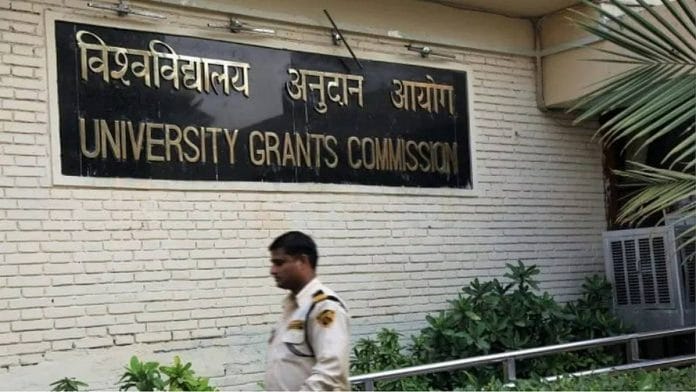New Delhi: Indian holy sites, Sanskrit language and literature, Indian logic, Vedic mathematics and rivers of India are among new short-term certificate courses to be taught in the country’s higher education institutions (HEIs), according to guidelines issued by the University Grants Commission (UGC) Tuesday.
The UGC has advised Indian universities to begin teaching courses on Indian heritage and culture in a bid to attract more foreign students.
Guidelines outlining the course structure list a bouquet of 46 courses, which will be divided into five units, each spread over 60 hours. The guidelines also give HEIs the flexibility to teach the courses in hybrid mode.
UGC chairman M. Jagadesh Kumar told ThePrint, “We definitely want more international students to come to India and study. In addition to contemporary India being founded on our ancient civilization because India is growing fast as a strong economy and Indians are doing well globally, there is a growing curiosity to know more about India.”
Kumar added that “stimulating subjects” ranging from Indian philosophy to temple architecture, literature to Indian food, and cultural heritage to Indian crafts can attract international students looking to gain a deeper insight into Indian culture.
“If universities can offer introductory level, intermediate level, and advanced level courses to these students, they will have a greater understanding of India,” he said.
In March this year, the UGC had released the draft of these guidelines, in line with the National Education Policy (NEP) 2020.
The guidelines describe the proposed courses as part of a “short term multi-tier credit based modular programme with multiple entry and exit based on Indian heritage and culture to promote the interest of people from abroad to visit India”.
“This includes dissemination and imparting of knowledge of various dimensions of learning in the spheres of Universal human values, Vedic Maths, Yoga, Ayurveda, Sanskrit, Indian Languages, sacrosanct religious regions located in the Indian subcontinent, Archaeological sites and monuments…,” read the guidelines.
They added that the courses can be offered at three distinct levels — introductory, intermediate and advanced — based on the degree of learning outcomes and the rigour of the curricular structure of relevant disciplines.
In March this year, a parliamentary panel on education had suggested that the Department of Higher Education issue guidelines for universities to introduce courses on Indian heritage and culture.
Also Read: 11,050 teaching posts vacant in central higher education institutes — DU, IIT-Kharagpur top list
Duration of courses, transferable credits
According to the guidelines, citizens of any country interested in Indian heritage and knowledge systems shall be eligible for admission to these courses. Upon the completion of every level, students will be given a certification in recognition of the same.
Professor Amarjiva Lochan, Joint Dean of Delhi University’s departments of international relations and foreign students, is of the opinion that while such courses could be an immediate hit among foreign students, institutions need to be mindful of the credit system and the duration.
“Several other countries too have such short-term courses which provide students the opportunity to earn extra credit through short term courses. These courses on Indian heritage will be of interest to exchange students and those coming to India through other education institutions, research institutions or the ministries,” he told ThePrint.
He pointed out that since HEIs will have to devote their faculty for these courses, they need to be mindful about the time duration. “Up to three months is the ideal time duration. In addition to this, the credits of these courses need to be transferable, so that it benefits the students,” he added.
According to the guidelines, the credit earned in such programmes shall be recognised under the credit transfer system by any of the Higher Educational Institutions (HEIs), with appropriate variables through the Academic Bank of Credit (ABC) for credit accumulation/redemption towards certification of academic awards in line with UGC norms.
The guidelines suggest that universities offering such programmes are free to decide specific eligibility conditions.
In order to make learning more diverse and effective, the guidelines suggest that students are to be exposed to contemporary and experts in the said subjects during their study.
“It is recommended to include discourse with learned educators (Acharyas), artists/artisans/craftsmen, confluence with religious devotees (Satsang), exposure to folk cultures and visit of famous places in the programmes, especially at advanced level under this scheme,” the guidelines read.
(Edited by Amrtansh Arora)
Also Read: Byju’s to Lido, India’s Edtech sector is leaking complaints. Unchecked power, no trust






